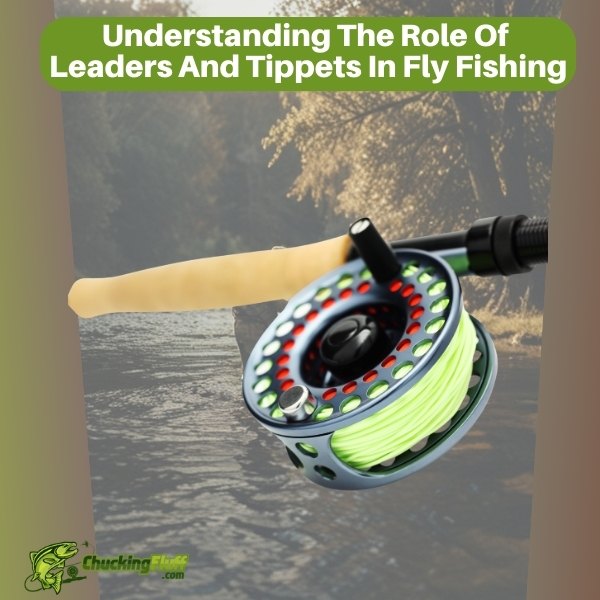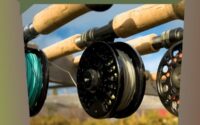| Disclosure: Just to be open and honest the buttons and links you click on in the website will in most cases take you to another website where you can purchase the products I am reviewing. As an Amazon Associate I earn from qualifying purchases. |
Understanding The Role Of Leaders And Tippets In Fly Fishing
Quick Post Navigation
- What Is a Leader in Fly Fishing?
- What Is a Tippet in Fly Fishing?
- Why Leaders and Tippets Matter in Fly Fishing
- Leader and Tippet Materials: Monofilament vs. Fluorocarbon
- Understanding Leader and Tippet Sizes (The X Rating System)
- Types of Leaders and Their Uses
- Types of Tippets and Their Uses
- How to Choose the Right Leader Length for Fly Fishing
- How to Choose the Right Tippet Strength for Fly Fishing
- Matching Leaders and Tippets to Fly Types
- When to Replace Leaders and Tippets?
- Conclusion
- FAQs About Leaders and Tippets
- “Check out some of our other Buying Guides”
Introduction
Leaders and tippets are the unsung heroes of fly fishing. They might not be as flashy as your fly rod or reel, but without the right leader and tippet setup, even the most expensive gear won’t deliver the results you want.
Think of your leader and tippet as the bridge between your fly line and the fly itself. They control how the fly presents, how naturally it drifts, and how stealthy you are in the water. In this deep dive, we’ll explore the roles leaders and tippets play in fly fishing success, breaking down the components, materials, sizes, and best practices.
What Is a Leader in Fly Fishing?
A leader is a clear, tapered length of material that connects your fly line to the fly. It plays a critical role in how your fly presents on the water by transferring energy from your cast while gradually tapering to a thinner, more delicate end near the fly.
The Anatomy of a Leader
A leader consists of three key sections:
- Butt Section: The thickest end of the leader, which attaches to the fly line. Designed for energy transfer and turnover.
- Tapered Midsection: The middle part of the leader that tapers down in diameter. This section helps control how the fly turns over during the cast.
- Tippet Section: The thinnest end of the leader where the fly is tied. Designed for stealth and minimal visibility.
Key Functions of a Leader
- Transfers casting energy from the fly line to the fly.
- Helps with fly turnover and accuracy.
- Reduces splash when the fly lands on the water.
- Provides stealth by extending the distance between the fly and the thick fly line.
What Is a Tippet in Fly Fishing?
The tippet is the final, thin portion of the leader where the fly is directly tied. It’s typically a straight, non-tapered segment of line designed for maximum invisibility and delicate presentations.
The Role of the Tippet
- Provides a nearly invisible connection between the leader and the fly.
- Absorbs shock during a fish strike, preventing breakoffs.
- Allows you to replace the final section of your leader without changing the entire setup.
How Tippet Works with the Leader
Think of the leader as the base and the tippet as the finishing touch. The leader manages casting energy, while the tippet ensures the fly lands naturally and drifts correctly.
Why Leaders and Tippets Matter in Fly Fishing
Understanding why leaders and tippets are so important will help you make better choices when setting up your rig. Here’s how they affect your fishing experience:
1. Presentation and Fly Turnover
The leader and tippet work together to ensure that the energy from your cast is smoothly transferred to the fly. A well-balanced setup prevents the fly from landing with a splash, making your presentation look natural — just like a real insect landing softly on the water.
2. Drift Control and Fly Behavior
A properly matched leader and tippet help you control the drift of your fly. Whether you’re fishing dry flies, nymphs, or streamers, the drift affects how your fly moves with the current, imitating natural prey movements.
3. Stealth and Fish Spooking Prevention
Fish, especially trout, are highly sensitive to unnatural disturbances. A thin, clear tippet minimizes the visibility of your line, helping you avoid spooking fish in clear water.
Leader and Tippet Materials: Monofilament vs. Fluorocarbon
Choosing the right material for your leader and tippet can significantly impact your success. The two most common materials are monofilament (nylon) and fluorocarbon.
Monofilament (Nylon)
- Buoyancy: Floats better, ideal for dry flies.
- Visibility: Slightly more visible than fluorocarbon.
- Stretch: Offers more flexibility, useful for shock absorption.
- Cost: Generally more affordable.
Fluorocarbon
- Buoyancy: Sinks faster, perfect for nymphs and streamers.
- Visibility: Nearly invisible underwater due to light refraction.
- Abrasion Resistance: Stronger and more resistant to nicks.
- Cost: More expensive but often worth it for spooky fish.
Understanding Leader and Tippet Sizes (The X Rating System)
The X rating system might seem confusing at first, but it’s essential for choosing the right setup. The “X” rating refers to the diameter of the tippet material, not its strength.
X Rating Chart
- 0X: Thickest, strongest, for large flies and heavy fish.
- 3X: Medium thickness for larger dry flies or nymphs.
- 6X: Fine diameter, ideal for small dry flies and delicate presentations.
The Rule of 3: Matching Fly Size to Tippet Size
A simple rule: Divide the fly size by 3 to find the right tippet size.
- Size 12 fly → 4X tippet.
- Size 18 fly → 6X tippet.
Types of Leaders and Their Uses
1. Tapered Leaders
- Pre-manufactured leaders with a gradual taper.
- Ideal for general fly fishing use.
- Smooth energy transfer for accurate casts.
2. Knotted Leaders
- Hand-tied leaders made from separate line segments.
- Offers better customization but can be more complex.
3. Specialty Leaders
- Euro Nymphing Leaders: Long, thin, and highly sensitive.
- Saltwater Leaders: Designed for larger species with stronger materials.
- Sink-Tip Leaders: Designed for sinking flies and streamer fishing.
Types of Tippets and Their Uses
1. Monofilament Tippet (Nylon)
- Best for dry flies due to its buoyancy.
- Easy to manage and knot.
2. Fluorocarbon Tippet
- Ideal for nymphing and wet flies.
- Sinks faster and offers better abrasion resistance.
3. Hybrid Tippet Materials
- Combines properties of both nylon and fluorocarbon.
- Balances strength, stealth, and versatility.
How to Choose the Right Leader Length for Fly Fishing
Leader length can make or break your presentation. Here’s how to decide:
- 7.5 ft: Short for small streams, tight casting areas.
- 9 ft: Standard for all-around trout fishing.
- 12+ ft: Best for clear water and wary fish requiring delicate presentations.
How to Choose the Right Tippet Strength for Fly Fishing
Tippet strength is measured by both pound test and X rating. The key is to balance strength and stealth.
- 2X to 4X: Larger flies and bigger fish.
- 5X to 6X: Ideal for trout fishing and smaller flies.
- 7X: Ultra-fine for tiny dry flies and extremely wary fish.
Matching Leaders and Tippets to Fly Types
- Dry Flies: Monofilament leaders and tippets, as they float better.
- Nymphs and Wet Flies: Fluorocarbon for better sinking.
- Streamers: Heavier tippets (0X-3X) for larger patterns and aggressive fish.
When to Replace Leaders and Tippets?
- Leaders: Replace when they become frayed, damaged, or lose their taper.
- Tippets: Replace more frequently, especially after landing multiple fish or breaking off.
Conclusion
Leaders and tippets are fundamental to your fly fishing success. They control presentation, accuracy, and how well you can fool fish in any water condition. Mastering their use will elevate your fly fishing game and make you a more effective angler.
FAQs About Leaders and Tippets
1. What’s the difference between a leader and a tippet?
A leader connects the fly line to the fly, while the tippet is the final section where the fly is tied.
2. How often should I change my leader and tippet?
Leaders can last several outings, while tippets should be replaced more frequently, especially after catching multiple fish.
3. Can I use fluorocarbon for dry flies?
Fluorocarbon sinks, making it less ideal for dry flies compared to monofilament.
4. What is the best tippet size for trout fishing?
5X tippet is a standard choice for most trout fishing situations.
5. Do I need different leaders for saltwater and freshwater fishing?
Yes, saltwater leaders are typically thicker and more abrasion-resistant than freshwater leaders.



